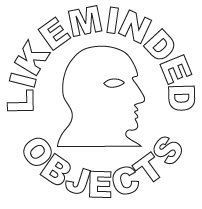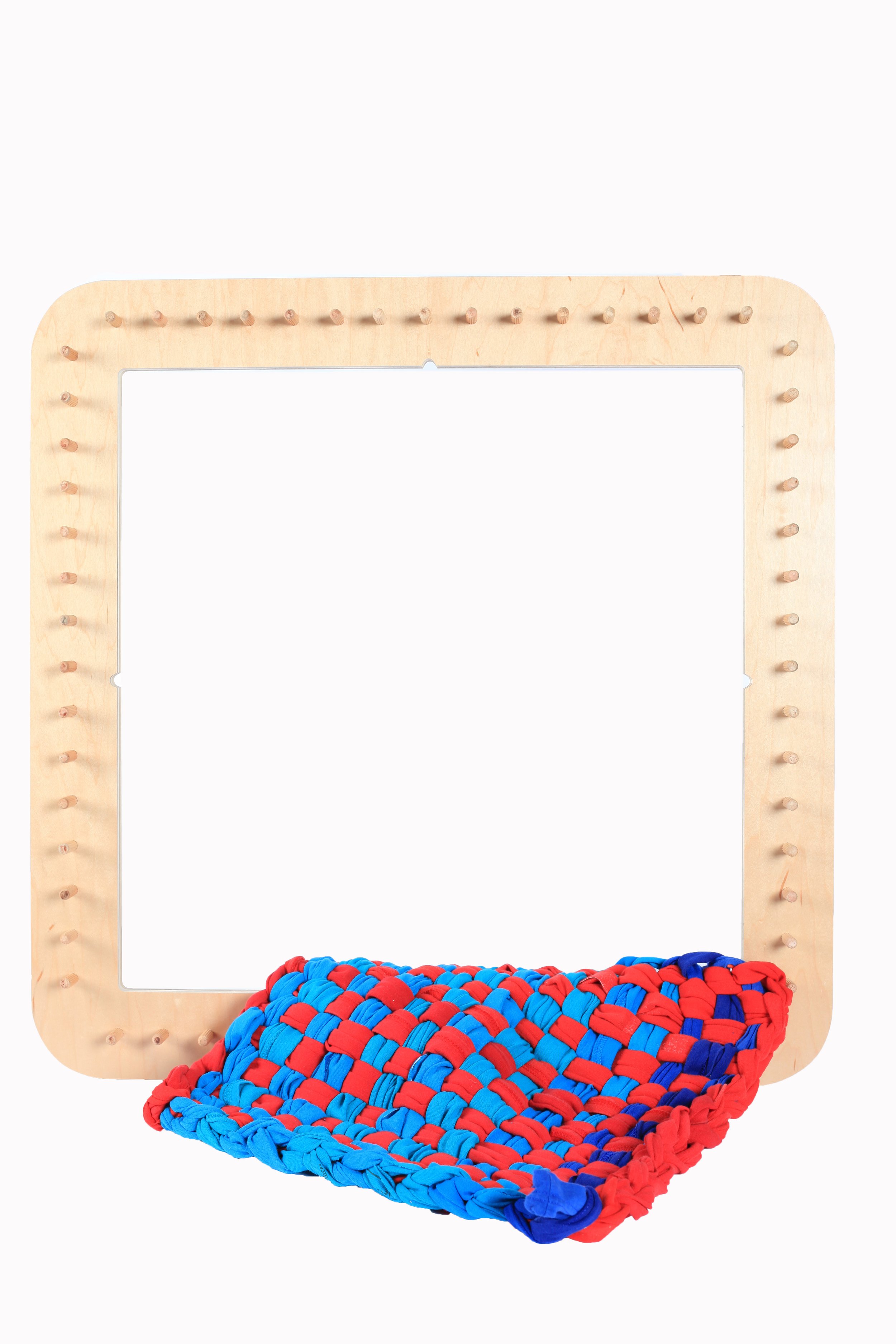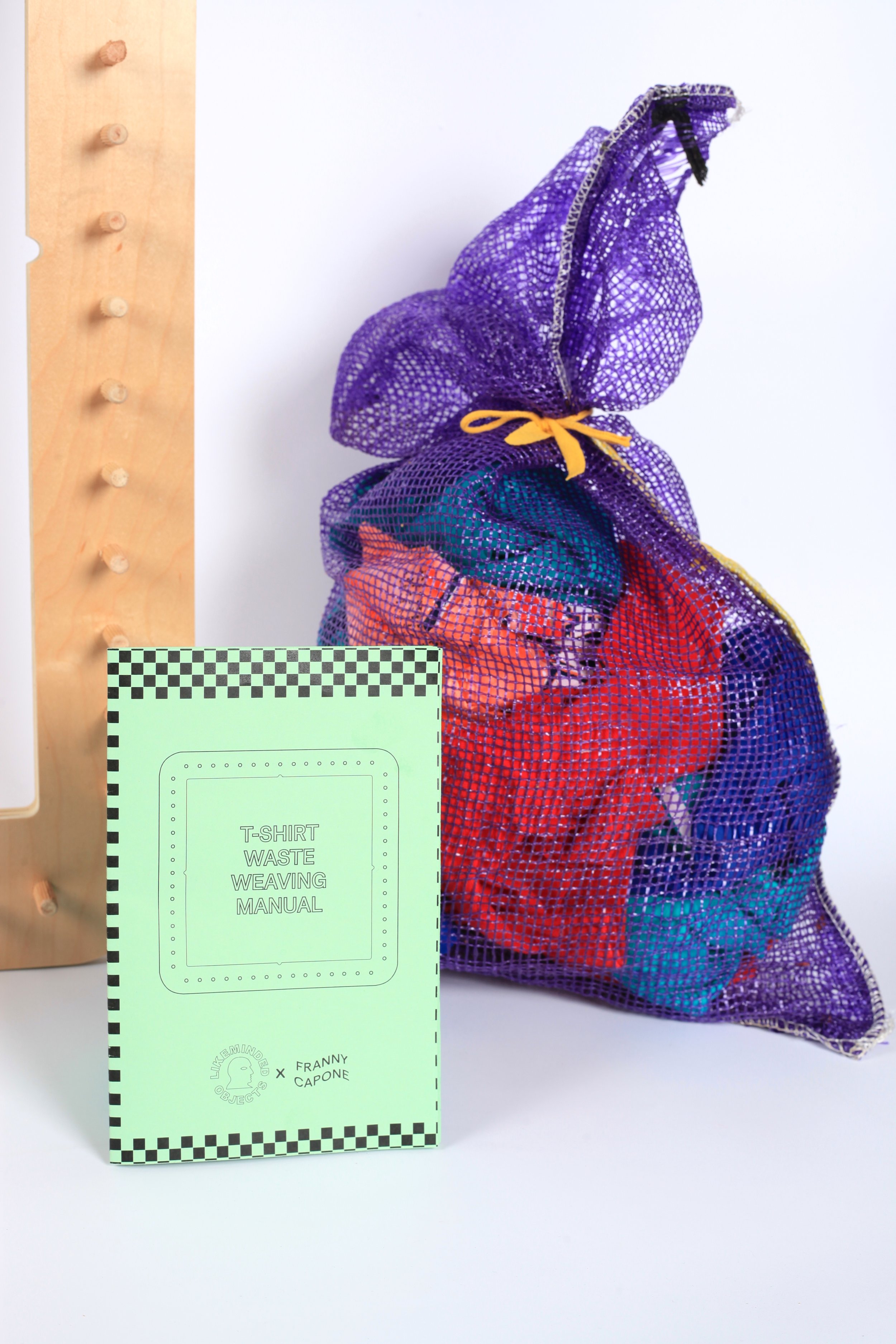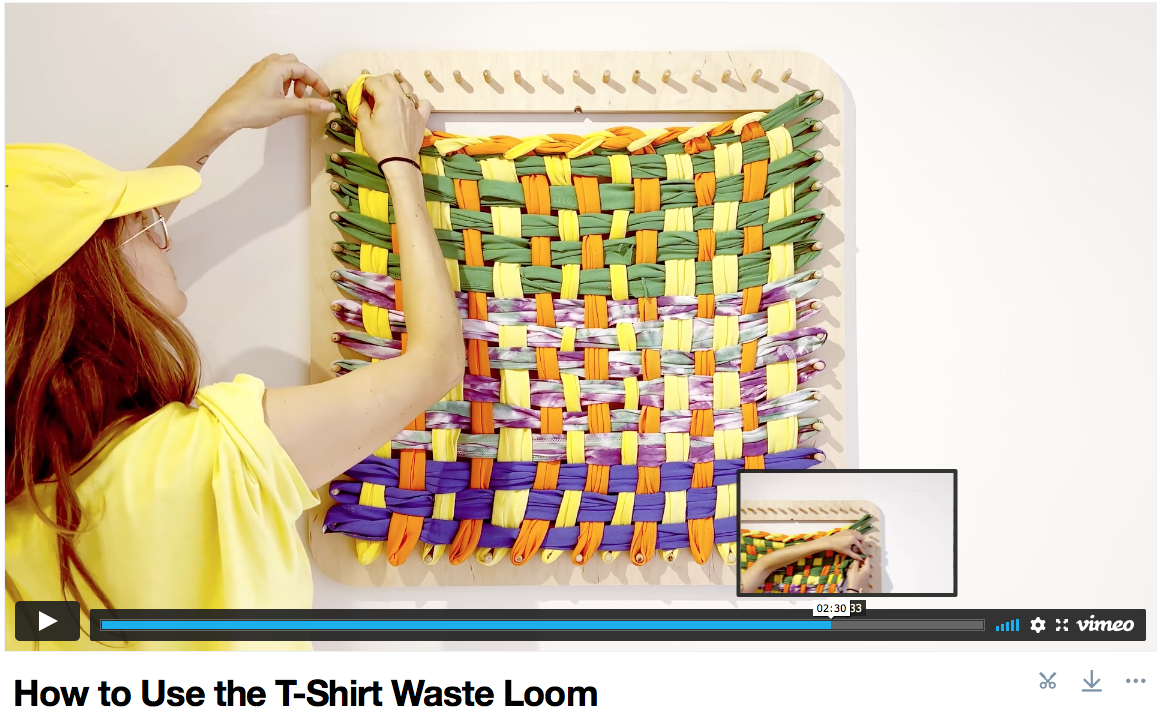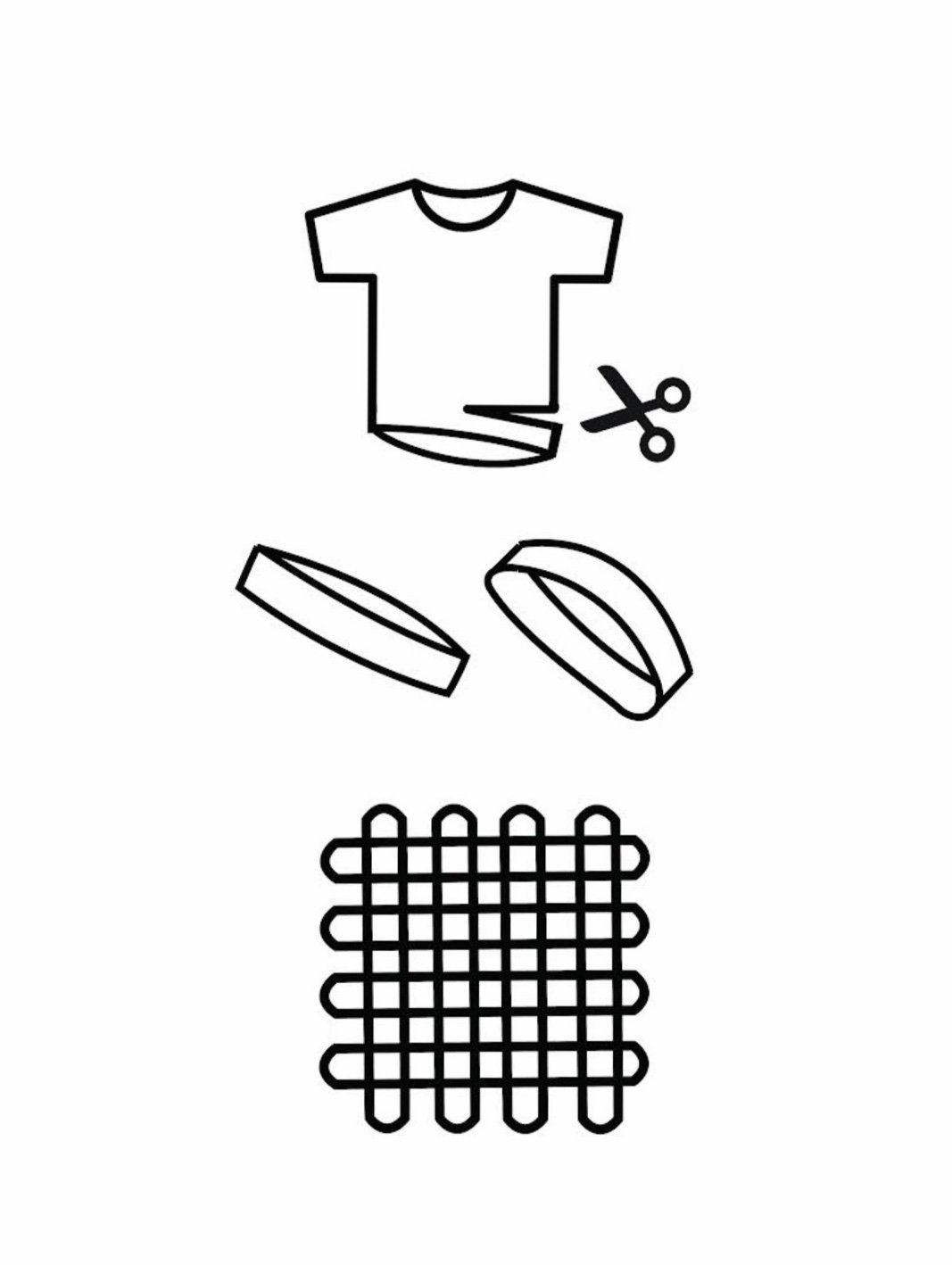T-SHIRT WASTE LOOM +Edu ToolKit
TSHIRT WASTE WEAVING EDUCATIONAL TOOLKIT: Loom, Book & Video
-How To Book comes with DIY loom making instructions and QR code linking to How To Video-
Material : Gloss Finish Maple Ply & Poplar Dowels
Dims : 27”x27”x3”
—————————-
Our Shared Vision
15 million discarded novelty t-shirts are imported to Ghana each month* under the guise of recycling and philanthropy. This is actually just the waste trade, the Global North polluting more vulnerable countries with overproduced garments.
There is a long, global precedent for creative approaches to upcycling discarded garments through weaving. In the Philippines, discarded textiles are woven into ubiquitous doormats known as Basahan*. In Indonesia there are Keset*, in Spain there are Jarapas*, in Morocco Boucherouite*, and the list goes on. These innovative and resourceful textiles are known to some, but largely go unrecognized. Sustainability practices such as these have been led and done for generations by BIPOC communities globally, often out of necessity. It is important that we acknowledge, honor, and learn from global craftspeople’s long standing efforts in managing waste streams.
This project comes out of the belief that it is time we, as individuals living in the United States, recognize our complicity in the effects of over consumption. Let’s do our part by taking responsibility for our own trash locally instead of expecting others to manage the burden of our waste.
This educational toolkit offers a DIY solution to the tshirt waste problem in the US by looking back on the potholder loom from the Great Depression, which utilized waste material from the 1930’s hosiery industry. By using this custom designed loom to facilitate a potholder style weaving method, it is possible to upcycle endless t-shirts into 18” x 18” tiles. These woven tiles can be modularly assembled for numerous functions of daily living, including upholstery fabric, blankets, pillows, and wearable items.
Created in collaboration between the design studio LikeMindedObjects and artist Francesca Capone, we are eager to empower creative individuals to utilize their own discarded t-shirts to bring new function to textile waste. Feel free to use the measurements of the loom provided in this book to DIY more looms for your community.
Please share your creations with our broader community by using the hashtag #tshirtwasteweaving - thank you for participating!
5% of all T-Shirt Waste Loom & Book profits go to the OR Foundation Second Hand Solidarity Fund to support their efforts in researching and mitigating the effects of the second hand clothing waste crisis in Ghana. You can learn more about the fund at solidarity.theor.org
—————————————————-
* T-Shirt Waste Research Referenced from the Or Foundation. For more information, please find them on Instagram @theorispresent or visit theor.org
*Basahan - Philippines https://www.tagalog-dictionary.com/search?word=basahan
*Boucherite - Morocco https://www.nytimes.com/2010/07/23/arts/design/23rags.html
*Jarapas - Spain https://en.wikipedia.org/wiki/Jarapa?wprov=sfti1
TSHIRT WASTE WEAVING EDUCATIONAL TOOLKIT: Loom, Book & Video
-How To Book comes with DIY loom making instructions and QR code linking to How To Video-
Material : Gloss Finish Maple Ply & Poplar Dowels
Dims : 27”x27”x3”
—————————-
Our Shared Vision
15 million discarded novelty t-shirts are imported to Ghana each month* under the guise of recycling and philanthropy. This is actually just the waste trade, the Global North polluting more vulnerable countries with overproduced garments.
There is a long, global precedent for creative approaches to upcycling discarded garments through weaving. In the Philippines, discarded textiles are woven into ubiquitous doormats known as Basahan*. In Indonesia there are Keset*, in Spain there are Jarapas*, in Morocco Boucherouite*, and the list goes on. These innovative and resourceful textiles are known to some, but largely go unrecognized. Sustainability practices such as these have been led and done for generations by BIPOC communities globally, often out of necessity. It is important that we acknowledge, honor, and learn from global craftspeople’s long standing efforts in managing waste streams.
This project comes out of the belief that it is time we, as individuals living in the United States, recognize our complicity in the effects of over consumption. Let’s do our part by taking responsibility for our own trash locally instead of expecting others to manage the burden of our waste.
This educational toolkit offers a DIY solution to the tshirt waste problem in the US by looking back on the potholder loom from the Great Depression, which utilized waste material from the 1930’s hosiery industry. By using this custom designed loom to facilitate a potholder style weaving method, it is possible to upcycle endless t-shirts into 18” x 18” tiles. These woven tiles can be modularly assembled for numerous functions of daily living, including upholstery fabric, blankets, pillows, and wearable items.
Created in collaboration between the design studio LikeMindedObjects and artist Francesca Capone, we are eager to empower creative individuals to utilize their own discarded t-shirts to bring new function to textile waste. Feel free to use the measurements of the loom provided in this book to DIY more looms for your community.
Please share your creations with our broader community by using the hashtag #tshirtwasteweaving - thank you for participating!
5% of all T-Shirt Waste Loom & Book profits go to the OR Foundation Second Hand Solidarity Fund to support their efforts in researching and mitigating the effects of the second hand clothing waste crisis in Ghana. You can learn more about the fund at solidarity.theor.org
—————————————————-
* T-Shirt Waste Research Referenced from the Or Foundation. For more information, please find them on Instagram @theorispresent or visit theor.org
*Basahan - Philippines https://www.tagalog-dictionary.com/search?word=basahan
*Boucherite - Morocco https://www.nytimes.com/2010/07/23/arts/design/23rags.html
*Jarapas - Spain https://en.wikipedia.org/wiki/Jarapa?wprov=sfti1
TSHIRT WASTE WEAVING EDUCATIONAL TOOLKIT: Loom, Book & Video
-How To Book comes with DIY loom making instructions and QR code linking to How To Video-
Material : Gloss Finish Maple Ply & Poplar Dowels
Dims : 27”x27”x3”
—————————-
Our Shared Vision
15 million discarded novelty t-shirts are imported to Ghana each month* under the guise of recycling and philanthropy. This is actually just the waste trade, the Global North polluting more vulnerable countries with overproduced garments.
There is a long, global precedent for creative approaches to upcycling discarded garments through weaving. In the Philippines, discarded textiles are woven into ubiquitous doormats known as Basahan*. In Indonesia there are Keset*, in Spain there are Jarapas*, in Morocco Boucherouite*, and the list goes on. These innovative and resourceful textiles are known to some, but largely go unrecognized. Sustainability practices such as these have been led and done for generations by BIPOC communities globally, often out of necessity. It is important that we acknowledge, honor, and learn from global craftspeople’s long standing efforts in managing waste streams.
This project comes out of the belief that it is time we, as individuals living in the United States, recognize our complicity in the effects of over consumption. Let’s do our part by taking responsibility for our own trash locally instead of expecting others to manage the burden of our waste.
This educational toolkit offers a DIY solution to the tshirt waste problem in the US by looking back on the potholder loom from the Great Depression, which utilized waste material from the 1930’s hosiery industry. By using this custom designed loom to facilitate a potholder style weaving method, it is possible to upcycle endless t-shirts into 18” x 18” tiles. These woven tiles can be modularly assembled for numerous functions of daily living, including upholstery fabric, blankets, pillows, and wearable items.
Created in collaboration between the design studio LikeMindedObjects and artist Francesca Capone, we are eager to empower creative individuals to utilize their own discarded t-shirts to bring new function to textile waste. Feel free to use the measurements of the loom provided in this book to DIY more looms for your community.
Please share your creations with our broader community by using the hashtag #tshirtwasteweaving - thank you for participating!
5% of all T-Shirt Waste Loom & Book profits go to the OR Foundation Second Hand Solidarity Fund to support their efforts in researching and mitigating the effects of the second hand clothing waste crisis in Ghana. You can learn more about the fund at solidarity.theor.org
—————————————————-
* T-Shirt Waste Research Referenced from the Or Foundation. For more information, please find them on Instagram @theorispresent or visit theor.org
*Basahan - Philippines https://www.tagalog-dictionary.com/search?word=basahan
*Boucherite - Morocco https://www.nytimes.com/2010/07/23/arts/design/23rags.html
*Jarapas - Spain https://en.wikipedia.org/wiki/Jarapa?wprov=sfti1
